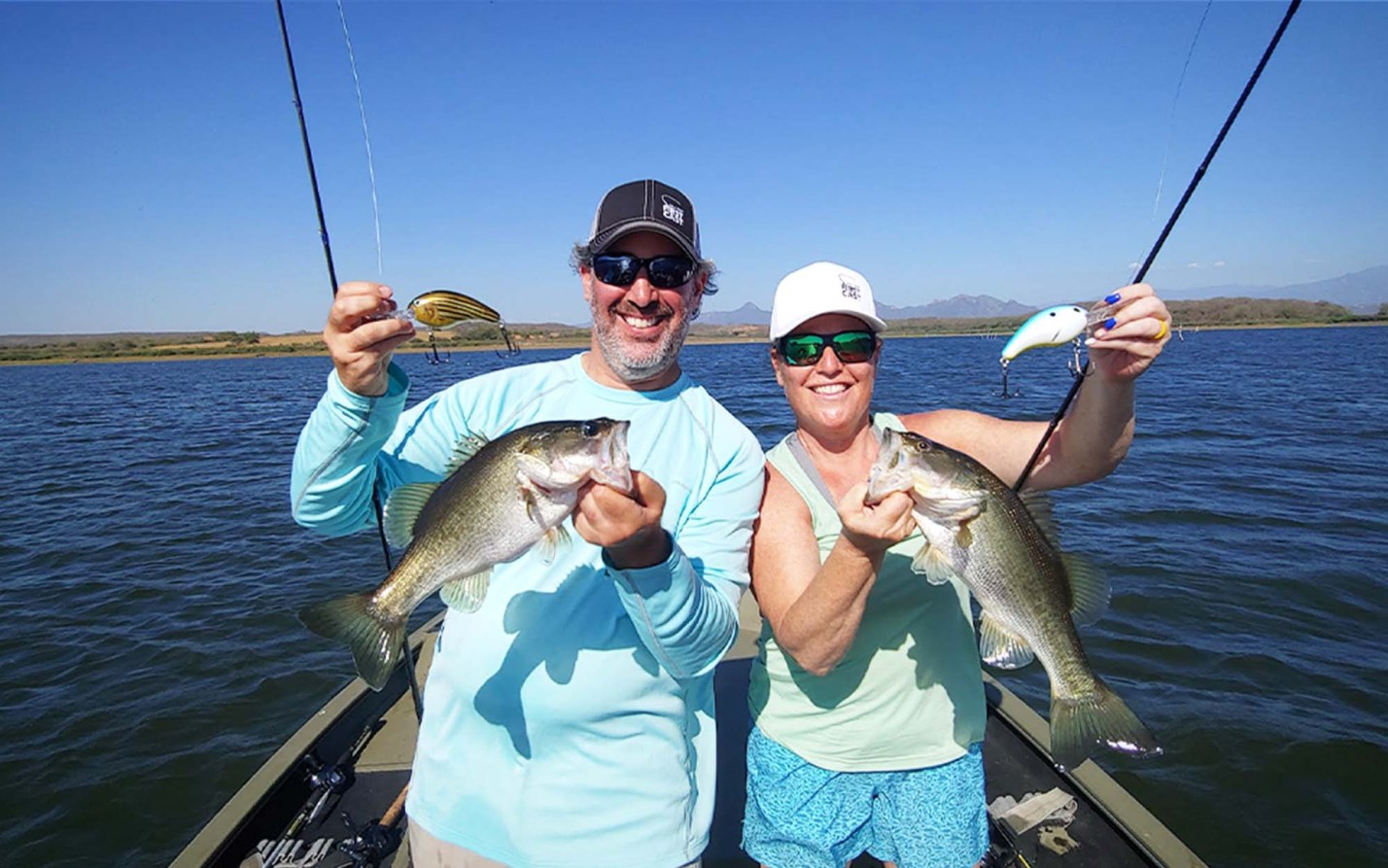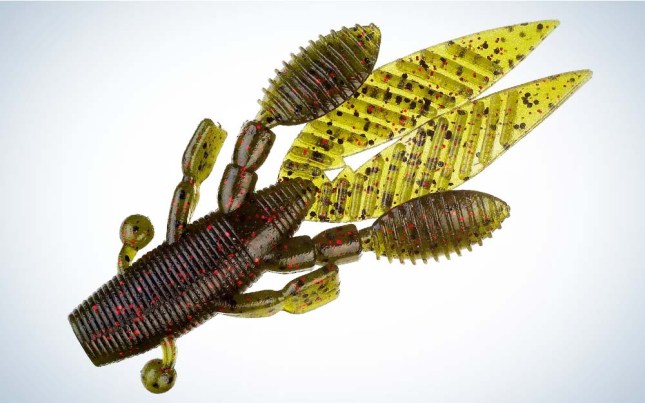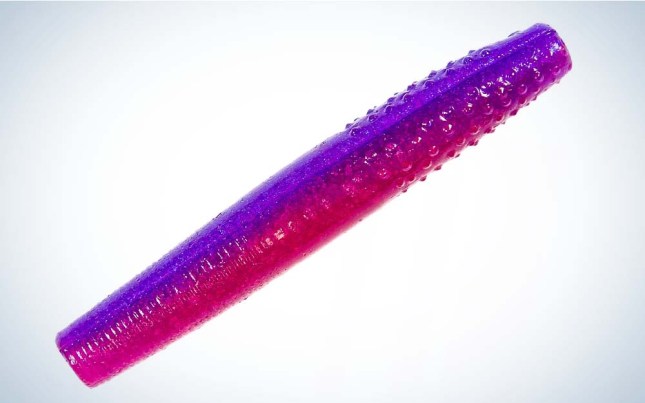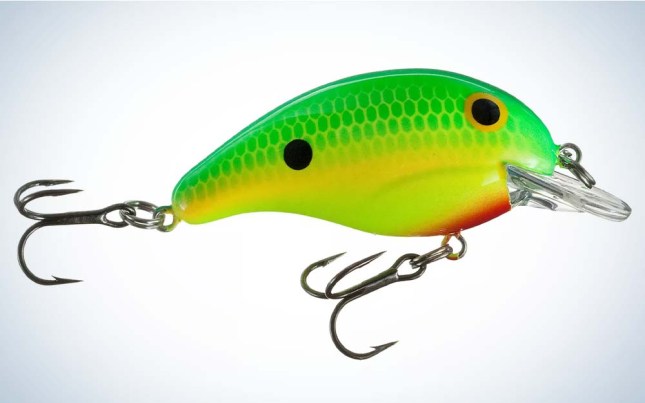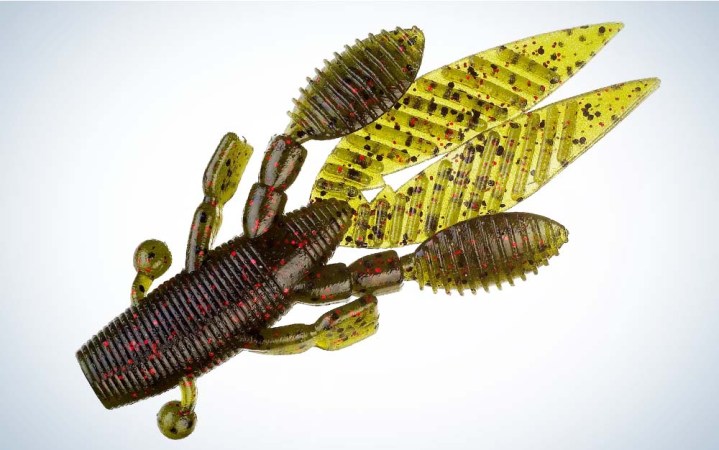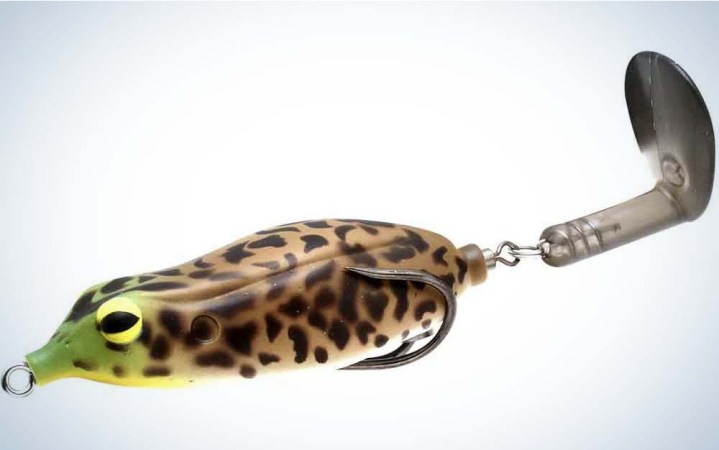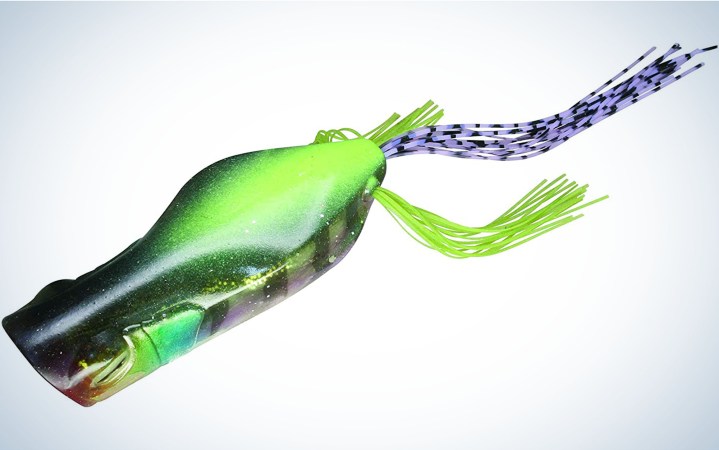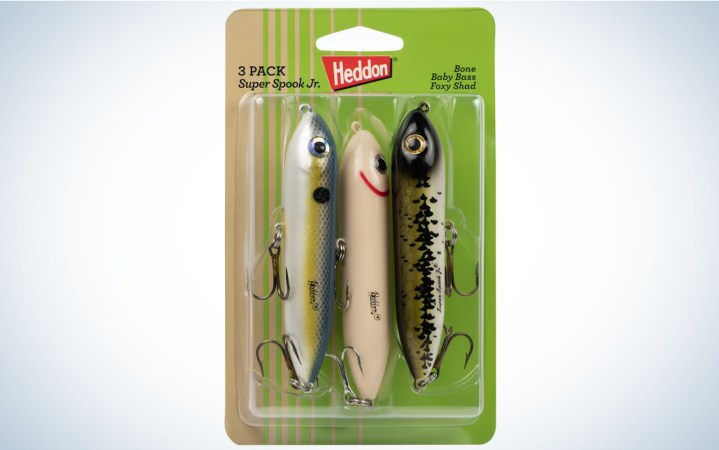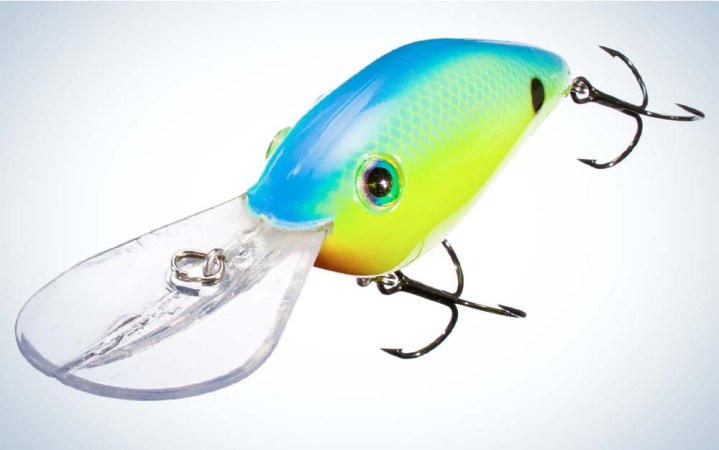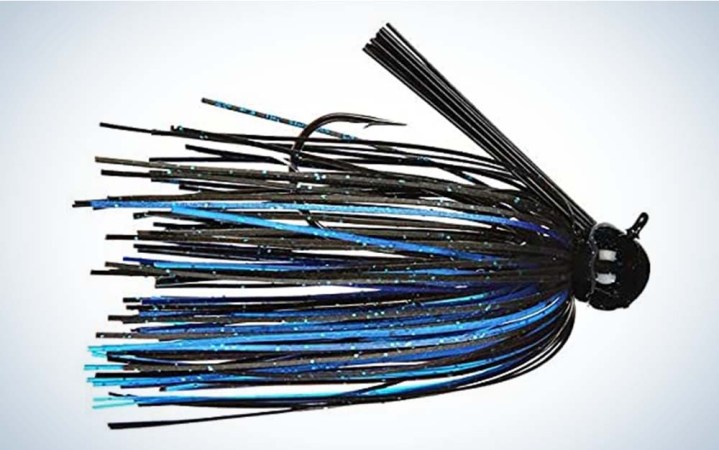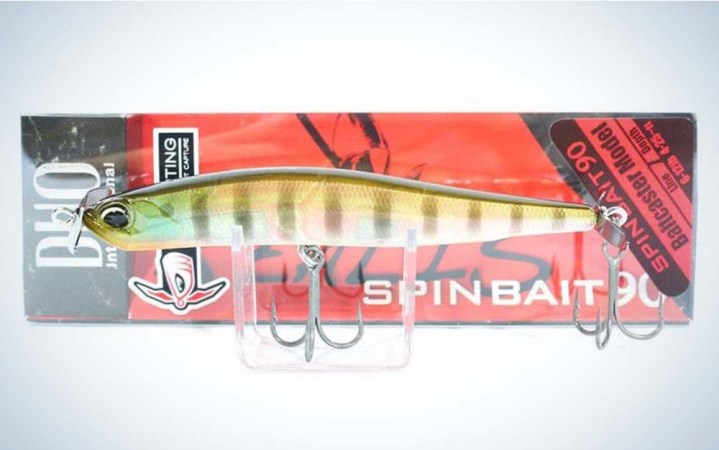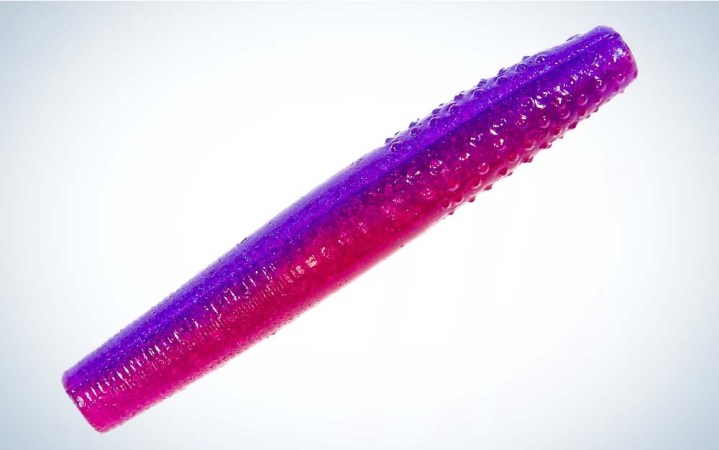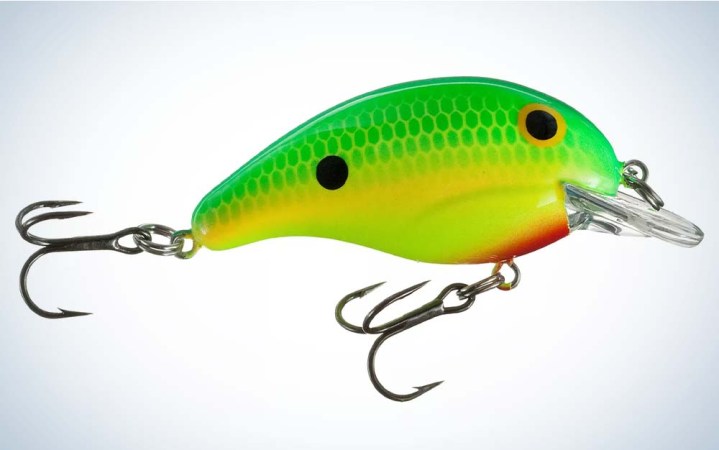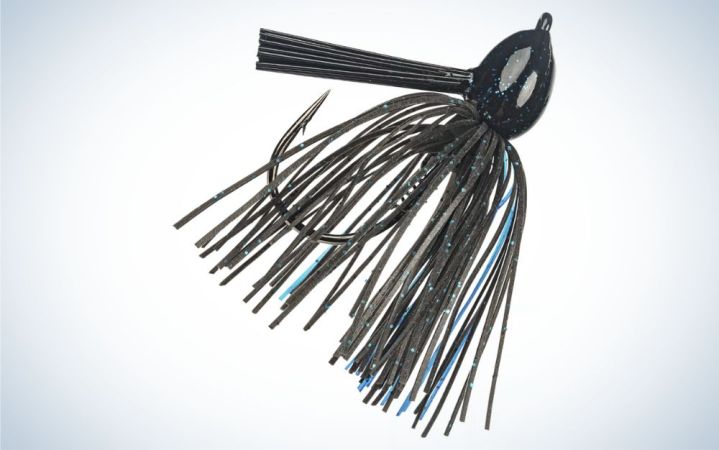We may earn revenue from the products available on this page and participate in affiliate programs. Learn More ›
The best bass lures for summer all take advantage of one key factor—when the going gets hot, fish don’t want to work for their food. Bass are ambush predators who revel in an easy meal, so presenting them with a tempting bait can make for excellent fishing.
Heat pushes bass to various extremes in the water column. On some lakes and particularly on tidal rivers, summertime bass will bury themselves in the thickest vegetation they can find, where food is plentiful. On other fisheries, like lakes with hydroelectric generation, they’ll go offshore and wait for the flow to fire up the bait. On creeks and streams they’ll sit behind current breaks and wait for the buffet line to drift their way. Use their laziness to your advantage, and whether you choose a big meal that triggers a reaction strike or something more natural that acts as an easy snack, remember that the hottest times of the year can also provide some of the hottest fishing if you have the best bass lures for summer in your tackle box.
- Best Punching Bait: Gary Yamamoto Flappin’ Hog
- Best Weedless Top Water: Teckel Lures Sprinker
- Best Frog: Jackall Gavacho
- Best Walking Bait: Heddon Super Spook Jr
- Best Deep Crankbait: Strike King 6XD Crankbait
- Best for Suspended Smallmouth: Duo Realis Spinbait Spybait
- Best for Ponds: Z-Man Finesse TRD
- Best for Creeks: Bandit 100 Crankbait
- Best for Heavy Cover Flipping (Fluorocarbon): Strike King Hack Attack Fluorocarbon Flipping Jig
How I Chose the Best Summer Bass Lures
For this review, I fished these bass lures in the many places where bass live and tried to figure out how to elicit the most strikes. Summertime might be the most diverse period of the year for choosing lures, because feeding bass can inhabit all portions of the water column and a wide variety of cover. They eat a range of prey, too, so tailor your selections and color choices to the local forage.
Best Bass Lures for Summer: Reviews and Recommendations
Best Punching Bait: Gary Yamamoto Flappin’ Hog
Key Features
- Size: 3.75 and 4.5 inches
- Three distinct appendages
- Compact body with hard-flapping legs and tails
Pros
- Appendages provide unique sound profile
- Compact body holds a big hook
- Hollow tail section allows easy hook penetration
Cons
- Not durable

Yamamoto, manufacturer of the famous Senko and Hula Grub, provides their take on a punching bait with the Flippin’ Hog a streamlined soft plastic that slips through thick grass, yet still has enough bulk to tempt the biggest fish in the lake. It’s at its best in jungle-like hydrilla, milfoil, or pennywort, behind a pegged tungsten weight from ¾ ounce all the way up to two ounces. That may sound like a mismatched pair, but the body form makes it look natural above and below the water. The hook and knot you use are critical for flipping. An Eagle Claw Lazer Sharp Flipping Hook tied directly to your braid with a snell knot, will give you the best hookups. Another tip on the flipping rig is that some anglers prefer to use a couple bobber stops above the weight instead of pegging it. You’ll want to throw your punching rig on a heavy power, moderate fast action rod with 65 pound braided line.
Best Weedless Topwater: Teckel Lures Sprinker
Key Features
- Frog-shaped body
- Plopper-style tail
- Weedless hook design
Pros
- Calls fish from a distance
- Lifelike eyes
- Great color selection
Cons
- Tail may occasionally get fouled
Japanese lure manufacturer Teckel took the ultra-natural body shape from their other frogs and put a spinning tail on the back, which means you can present an altogether new sound profile to bass that are used to silent topwater amphibians. You can think of this frog a lot like a weedless Whopper Plopper, and it excels at quickly covering water in or around thick vegetation. The hooks are tucked neatly against the side of the body to minimize fouling, but the plastic bends easily to maximize hookups on both aggressive and tentative strikes. You can simply cast out the Sprinker and reel it in or work in pauses to trigger a strike. My favorite way to use the Sprinker is cast it parallel to the edge of lily pads and work it back. You can cover the entire edge—where active fish will lurk—in just a few casts. The biggest con of the Sprinker is that the tail is will get chewed up or ripped off. You can buy replacement tails though and I recommend stocking up on them.
Best Frog: Jackall Gavacho
Key Features
- Length: 2.75 inches
- Weight: ⅔ ounce
- Six colors
Pros
- Easy to work
- Casts a long distance
- Covers many situations
Cons
- Doesn’t come through cover as well as a walking frog
There aren’t many times I don’t have a Gavacho tied onto my line because there aren’t many situations where it doesn’t excel. If I’m fishing a pad field, I can bring the bait into an opening and walk it in place. If there’s some chop on the water I can pop the frog. I have no problem quickly walking it down a weed edge. The only time it doesn’t shine is in really thick vegetation because the cupped face doesn’t come through cover as cleanly as the pointed head of a walking frog.
I also like that working the Gavacho takes very little effort, and the slim profile means I get more eats with fewer short strikes. The hooks on it are the right thickness, so they won’t bend out when you’re winching a fish from the slop, but they’re thin enough that they still penetrate easily. Another design feature that aids in hookup ratio is the soft body, which easily collapses and exposes the hooks. —Scott Einsmann
Best Walking Bait: Heddon Super Spook Jr
Key Features
- Sizes: 3 ½ inches (1/2 oz), 5 inches (7/8 oz)
- Distinguishing characteristics: Cigar-shaped body with loud rattles
- Key colors: Bone, Black Shore Shad, Okie Shad
Pros
- Makes a lot of noise
- High-quality hooks
- Walks easily
- Broad range of colors
Cons
- Not the most natural body shape.
- Not necessarily the best choice on streams or the Great Lakes
There may be more modern and more natural-looking “walk the dog” topwaters, but this upgraded version of the original from Heddon is the best topwater smallmouth candy. It walks easily and calls big brown bass from a distance, or from the depths. They strike it extra hard, too, which means you’ll also need to invest in a quality pair of pliers to remove the premium Excalibur Rotating Treble Hooks.
There’s no more exciting way to catch a post-spawn bronzeback than with a topwater lure, and few surface tools have been getting the job done longer than Heddon’s Zara Spook. You can still use the original effectively, but this upgraded version, the Heddon Super Spook, has all of the extra bells and whistles to grab a few more bites and to keep them hooked up. The smaller “Junior” version is often smallie anglers’ first choice, but don’t hesitate to go to the five-incher, especially in wind and waves where you need to make a ruckus to grab their attention. It’s worth noting this isn’t just one of the best topwater lures for smallmouth bass, it’s also one of the best bass lures of all time.
Best Deep Crankbait: Strike King 6XD Crankbait
Key Features
- Size: 3 inches, 1 ounce
- Dives over 17-feet deep
- Casts a mile
Pros
- Huge color selection
- Runs true out of the package
- Hydrodynamic design hits max depths in a hurry
Cons
- Prone to snags on deep stumps or brush
When summertime bass are schooled up and waiting for baitfish to swim by, nothing gets them going and keeps them going like a big crankbait. The 6XD gets into the strike zone quickly and stays there, and unlike some competitors it doesn’t pull so hard that it wears you out. It also comes in a “Hard Knock” version with a more aggressive sound profile. This is the crankbait the pros turn to when the offshore bass are chewing. And don’t be surprised if you occasionally catch two at a time. When throwing the 6XD make sure you have the right crankbait rod, one that will allow you to feel the bait bounce of cover and keep fish hooked after they bite.
Best Summer Lure for Finicky Offshore Bass: Dirty Jigs Tour Level Finesse Football Jig
Key Features
- Sizes: 3/8, ½, and 5/8 ounce
- Gamakatsu 4/0 jig hook
- Full-length skirts
Pros
- Highly-detailed skirt colors
- Light wire hook for rock-solid hook sets in deep water
- Pairs with a wide variety of soft plastic colors
Cons
- Shouldn’t be used with braided line
Dirty Jigs has quickly become one of the pros’ most valuable lineups of leadhead jigs for everything from flipping to pitching to swimming. But this finesse jig is made to be hopped and dragged along the bottom. It provides a compact profile and a light wire hook to get solid hooksets at just about any depth but also enough weight to get to the bottom and stay there. In addition to a wide range of standard colors, they offer some options not found anywhere else.
Best Summer Bass Lure for Suspended Smallmouths: Duo Realis Spinbait Spybait
Key Features
- Sizes: 3.14, 3.5, and 4 inches
- Flat sides and tall profile
- Two free-spinning propellers
Pros
- Hard-flashing profile
- Signature rolling action
- Razor-sharp hooks
Cons
- Can’t be fished effectively on heavy line
The Spinbait has given rise to a whole host of copycats, but the original remains the gold standard. It looks like an old-school Devil’s Horse topwater, but instead of staying on the surface it sinks. That means it can be counted down to the desired depth and then slow-rolled back to the boat through the strike zone. Largemouths and spotted bass love it too, but it’s really proven the most deadly on smallmouths in the Great Lakes region.
Best Summer Bass Lure for Ponds: Z-Man Finesse TRD
Key Features
- Size: 2.75 inches
- Ultra-durable ElaZtech plastic
- Buoyant
Pros
- ElaZtech plastic is tougher than other soft lure materials
- Lure stands up when placed on a light jighead
- No negative cues to educate fish
Cons
- Doesn’t call bass from a distance

Ned rigging—placing a small, stubby piece of plastic on a mushroom-shaped jighead—was once thought to be the province of beginners, but as more and more anglers win national tournaments with this simple technique, it’s become a standard in boats and tackle boxes everywhere. The Z-Man Finesse TRD remains the standard bearer. Not only is it super tough—so you won’t need to constantly re-rig or replace your lure—but it is also buoyant, so when sent to the bottom, the tail stands up, calling fish to investigate. Throw the TRD on the lightest Ned rig head that will get the bait to the bottom. Once your bait hits the bottom watch the line carefully. If the line doesn’t jump or swim away—indicating a strike— slowly drag the Ned rig across the bottom. You can also pop it off the bottom and let it fall again. It’s an absolutely deadly technique for catching largemouth and smallmouth bass in anybody of water. Just keep in mind that the ElaZtech material cannot be stored in contact with other soft plastics. It’s best to keep these baits in their original packaging and away from high temps.
Best Summer Bass Lure for Creeks: Bandit 100 Crankbait
Key Features
- Size: 2 inches, ¼ ounce
- Runs 2-5 feet
- Loud internal rattles
Pros
- Encyclopedic color selection
- Compact profile
- Can be thrown on spinning or baitcasting tackle
Cons
- Struggles in brush or grass
While soft plastics and simple inline spinners often get the call for novice stream anglers, advanced practitioners are aware that a crankbait can provoke strikes when other lures won’t. The Bandit 100 roots around like a foraging crawfish, and the wide wobble makes it an easy target. It’s great around rocks—bring it down through a riffle or behind a current-blocking boulder and a waiting bass may jump out and smash it. If it threatens to hang up, just back off and let it float away from the cover.
Best for Heavy Cover Flipping (Fluorocarbon): Strike King Hack Attack Fluorocarbon Flipping Jig
Key Features
- 60 strand silicone skirt
- Corkscrew wire baitkeeper
- Thinner-diameter hook than those made for braid
- 3/8, ½, and ¾ ounce sizes
Pros
- Great color selection
- Smaller diameter hook penetrates with less effort
- Same weedguard as original Hack Attack jig
Cons
- You’ll probably need another jig if braid is required
Strike King makes a wide range of situationally-specific jigs tailored to the pros’ needs. Among them is the original Hack Attack jig, which withstands the hardest braided fishing line poundings. Sometimes, though, the same pointed head style is needed with a lighter hook, especially when using fluorocarbon. That’s where this jig gets the call, and I find it exceptional when flipping and pitching for pressured bass. Yes, you can use it with braid, but the one-two punch of this and the original are a deadly duo when switching back and forth between some of the best fishing lines for bass. I especially like the fact that Strike King has incorporated favorite regional colors into the lineup like Bama Craw, Okeechobee Craw, and Falcon Lake Craw, but it’s no secret that they don’t just work on their namesake lakes.
Things to Consider Before Buying the Best Bass Lures for Summer
There are two main types of feeding behavior among bass during the summer—those that can be triggered and those that have to be convinced. Luckily, if you have a selection of the best bass lures for summer, you can do both. Fast moving lures often trigger bass, while painfully slow presentations are often best for convincing them to strike. When rigging up for summer bass fishing, you’ll also want to consider the color of the bait as well as the type of cover and water depth you’re fishing.
Color
Lure color selection is part science and part superstition. While we can debate the effectiveness of watermelon with green flake and watermelon with red flake, there’s a few simple rules to follow when picking bass lure colors. If the water is clear, go with natural colors. If there’s low visibility, go with solid or bold colors. The natural colors are more likely to fool fish that can see every detail of your lure in clear water. In murky conditions you need to help bass see your bait so a bright color will help the lure standout, and solid black will help the lure’s silhouette be visible.
Type of Cover
Also, consider the cover that they’re inhabiting. A bass on a featureless ledge or suspended over a flat might hit a lure that has multiple treble hooks, while one buried in a grass mat or deep within the confines of a brush pile might require a single-hooked weedless approach. If you’re fishing thick vegetation a weedless jig, soft plastic, or topwater frog are an excellent choice. If you’re fishing wood or rocks, you can fish a wide range of options like crankbaits, spinnerbaits, swimbaits, and jerkbaits to quickly cover water and find active fish.
Water Depth
Baits you fish in 1 to 5 feet of water will be different from those you use to catch fish offshore. In general, a heavier lure or one with larger diving lip will work best for deep water. Light lures or topwaters are best for shallow water. The exception is when you’re punching matted vegetation in shallow water or fish are feeding on the surface in deep water.
FAQs
Largemouth bass are omnivorous and eat a wide range of baitfish, terrestrial creatures, and insects. But in the summer it’s all about expending minimal energy. They’ll use current in their favor and stack up on likely ambush spots to target baitfish or other insects that drift behind boulders on a stream, along grass edges, or on river ledges with current.
Bass, particularly largemouths, are like humans–they want “air conditioning.” That means shade, current, oxygen, or all three. In shallow water, they’re likely to hide in the thickest cover, such as grass mats, hiding from the sun’s rays. In deeper water, they’ll be wherever they can expect to get the full benefit of a flow. Sometimes, they don’t hide at all but follow pelagic baitfish around the lake.
Coming off the spawn but before they get out deep, bass are often guarding fry or chasing bait. In the former instance, a lure that irritates them and threatens their young, like a frog, can be exceptional. In the latter case, go for a mid-depth or deep-diving crankbait. Bounce it off cover on likely current breaks. After you catch one, get your lure back in the strike zone quickly because you might have fired up the school.
Final Thoughts on the Best Bass Lures for Summer
Summertime fishing isn’t as easy as the spawn, when just about every bass in a lake or river will move shallow at nearly the same time. While this time of year hits uncomfortable temps and even triple digits, it’s still not as bad as dormant winter conditions. Just think of how the climate makes you feel and assume that bass feel the same way. They still want to eat, but they don’t want to work up a sweat to get the job done. That means they’ll burrow under overhead canopies or down into current breaks and strike when the opportunity presents itself. If you think like them, and find the best bass lures for summer to get into those zones, you can absolutely clean up.
